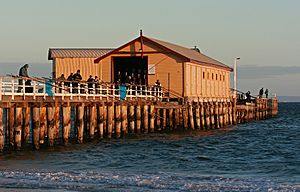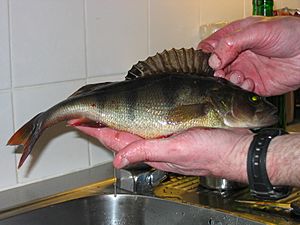Jigging facts for kids
Jigging is a way of fishing using a special type of lure called a jig. A jig has a heavy lead part with a hook built in. It's often covered with a soft, colorful body to attract fish. Unlike lures that move sideways, jigs are designed to move up and down in the water with a jerky motion.
Jigs are super useful and work in both fresh water and the ocean. Many different kinds of fish love them, which is why they've been popular with fishermen for a long time. To jig well, you need a fishing rod that helps you feel when a fish bites. You also need to keep your lure close to the fish, usually near the bottom of the water.
Contents
Jig Heads: Shapes and Colors
The head of a jig comes in many shapes and colors. The most common shape is round. Other shapes look like fish heads or cones. For bass fishing, popular jighead shapes include the flipping jighead, football jighead, and grass jighead.
Jig heads also come in many different weights. They can be as light as 1/80th of an ounce or as heavy as almost a pound for catching big fish in the ocean. You can find them in all sorts of colors and patterns too. The hooks on jig heads also vary in type, color, and how they are angled. Some even have a special guard to stop weeds from getting caught on them.
Jig Bodies: What They're Made Of
Jigs have a huge variety of bodies. Most often, they are made from rubber or silicone. These bodies come in many shapes, like grubs, frogs, fish, or different insects. Their colors can be bright yellow, clear brown with shiny flakes, or even blue with black hair. During warmer months, colors like browns or blue with black are often used.
Sometimes, real bait like small fish (minnows), leeches, or worms (night crawlers) are used as jig bodies.
Traditional Jig Bodies
Some older, more traditional jigs use natural or dyed hair from a whitetail deer's tail on the outside. These are called bucktail jigs. They are very popular in the northern and midwestern parts of the United States. Many fishermen still tie these jigs by hand.
Other Materials for Jig Bodies
Other materials are also used to make jig bodies. These include a soft wrap called Chenille around the hook, different types of feathers, animal hairs or fur, and shiny materials like Flashabou. Making these bodies is often similar to how people make artificial flies for fly fishing. Some jigs are even made exactly like certain fishing flies, but they are tied onto a jig head instead.
Jig bodies can be very brightly colored or more natural. They are often designed to look like the small fish or large insects that fish in that area usually eat.
Images for kids
See also
 In Spanish: Jigging para niños
In Spanish: Jigging para niños





